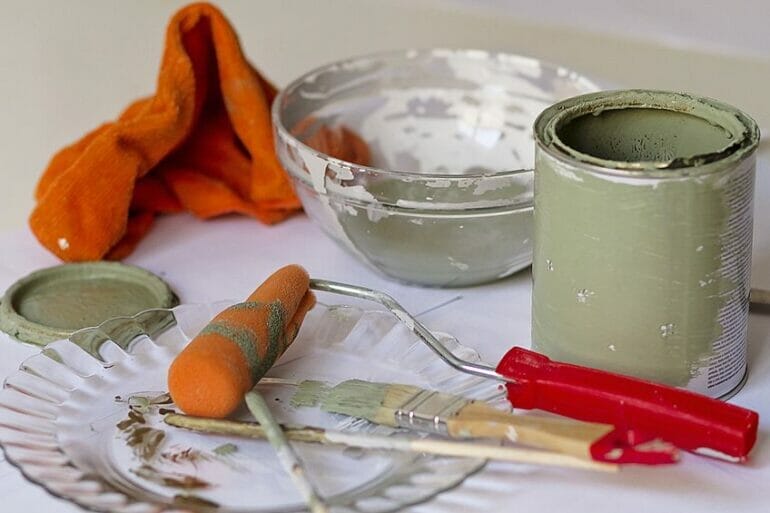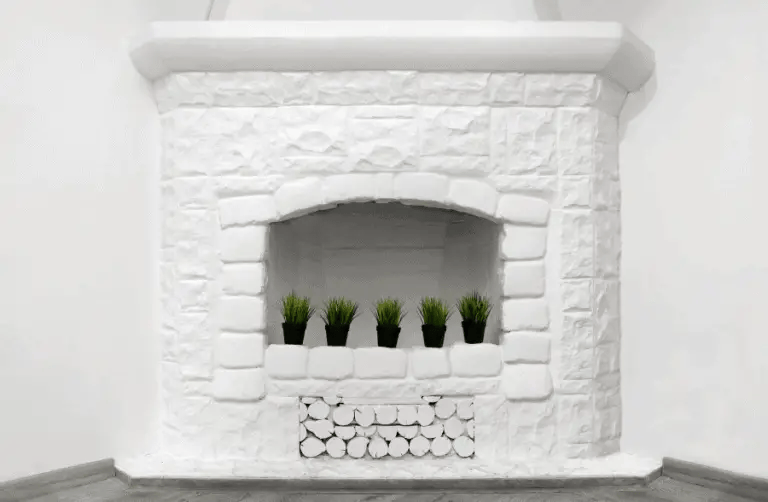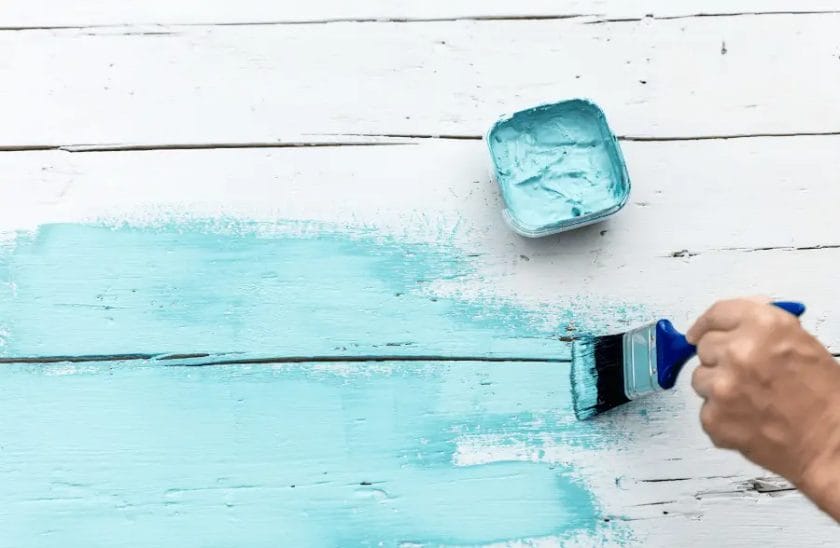Chalk paint has gained popularity due to its versatility and aesthetic appeal in the world of interior design and DIY projects. However, when it comes to flammability, it’s essential to understand the potential risks.
Chalk paint itself is not considered highly flammable, as it typically contains water, calcium carbonate, and other non-combustible ingredients. This makes it a safer option compared to other types of paint.
However, it’s important to note that some chalk paint brands may contain additives or solvents that could increase flammability. To ensure safety, always check the product labeling and consult the manufacturer’s instructions before using or storing chalk paint.
When using chalk paint, it’s crucial to follow proper ventilation practices and keep it away from open flames or heat sources. Additionally, store chalk paint in a cool, dry place, away from direct sunlight, to minimize the risk of any potential flammability.
By being aware of the ingredients and taking necessary precautions, you can enjoy the benefits of chalk paint while maintaining a safe environment for your DIY projects.

Understanding the Flammability of Chalk Paint: What You Need to Know
Chalk paint has gained significant popularity in recent years for its ability to transform furniture and other surfaces with a vintage, matte finish. While chalk paint offers many advantages, it is important to understand its flammability characteristics to ensure safe usage and storage.
Chalk paint, like any other paint, contains a combination of volatile organic compounds (VOCs) that contribute to its chemical composition. These VOCs can potentially make the paint flammable under certain conditions.
When exposed to heat sources such as open flames, sparks, or high temperatures, chalk paint can ignite and propagate a fire. Therefore, it is crucial to take necessary precautions when working with or storing chalk paint.
Factors Affecting the Flammability of Chalk Paint
Several factors influence the flammability of chalk paint:
- VOC Content: The higher the VOC content in the paint, the greater the risk of flammability. It is essential to check the VOC levels specified by the manufacturer.
- Application Method: The application method can impact the paint’s flammability. Spraying or aerosolizing chalk paint increases the risk due to the fine mist particles that can easily ignite.
- Drying Time: Adequate drying time is crucial to minimize the risk of flammability. If the paint is not fully cured, it may remain more susceptible to ignition.
- Surface Porosity: Chalk paint adheres best to porous surfaces. If applied to non-porous surfaces such as metal or glass, the risk of flammability may increase.
Precautions to Minimize the Risk of Chalk Paint Flammability
To ensure safe usage of chalk paint, consider the following precautions:
- Ventilation: Always use chalk paint in a well-ventilated area to minimize the concentration of VOCs and prevent the buildup of flammable vapors.
- Keep Away from Ignition Sources: Avoid using chalk paint near open flames, sparks, or any potential ignition sources to reduce the risk of fire.
- Proper Storage: Store chalk paint in a cool, dry place away from heat sources and direct sunlight. Ensure the lids are tightly sealed to prevent evaporation and minimize the flammability risk.
- Dispose of Properly: When disposing of empty paint cans or unused paint, follow local regulations and guidelines. Do not dispose of them in regular household waste if they contain flammable substances.
Summary
Understanding the flammability characteristics of chalk paint is essential for safe and responsible usage. By considering factors such as VOC content, application method, drying time, and surface porosity, you can minimize the risk of flammable incidents. Remember to prioritize proper ventilation, keep the paint away from ignition sources, store it correctly, and dispose of it responsibly. With these precautions, you can enjoy the transformative power of chalk paint while ensuring your safety.

Fire safety precautions when using chalk paint: A comprehensive guide
Chalk paint has gained popularity in recent years for its ability to transform furniture and other surfaces with a unique matte finish. While it is a versatile and user-friendly paint, it is important to be aware of fire safety precautions when using chalk paint to ensure a safe and enjoyable painting experience. In this section, we will discuss a comprehensive guide on fire safety precautions that should be followed when working with chalk paint.
1. Choose a well-ventilated area
When using chalk paint, it is essential to work in a well-ventilated area to minimize the risk of fire hazards. Open windows and use fans to ensure proper air circulation. This will help prevent the accumulation of flammable vapors and reduce the chances of a fire breakout.
2. Keep flammable materials away
It is crucial to keep flammable materials such as paper, fabric, and solvents away from the painting area. Chalk paint contains additives that can make it highly flammable, so it is important to exercise caution and maintain a safe distance from any potential fire hazards.
3. Use non-flammable containers
When storing or mixing chalk paint, it is advisable to use non-flammable containers. Avoid using plastic or paper containers that can easily catch fire. Opt for metal or glass containers that are less likely to ignite and contribute to a fire.
4. Keep a fire extinguisher nearby
Having a fire extinguisher readily available in the painting area is crucial for quick response in case of a fire emergency. Make sure you are familiar with how to use the fire extinguisher and that it is fully charged and in good working condition.
5. Use proper lighting
Ensure that the painting area is properly lit to avoid accidents. Adequate lighting will allow you to see any potential fire hazards or spills and take appropriate action to prevent a fire.
6. Avoid smoking or open flames
Smoking or having open flames in the painting area is extremely dangerous and can lead to a fire. Always extinguish any open flames or smoking materials before starting your painting project.
7. Store chalk paint properly
When not in use, store chalk paint in a cool, dry place away from direct sunlight and heat sources. Ensure that the paint containers are tightly sealed to prevent evaporation of flammable components.
8. Clean up spills promptly
Accidental spills can happen during the painting process. It is important to clean up any spills promptly to prevent the paint from accumulating and becoming a fire hazard. Use appropriate cleaning materials and dispose of them safely.
9. Follow manufacturer’s instructions
Always read and follow the manufacturer’s instructions on the chalk paint product. They provide essential information on handling, storage, and proper usage, including any specific fire safety precautions that should be followed.
Summary
In summary, when using chalk paint, it is essential to prioritize fire safety precautions to ensure a safe painting experience. This comprehensive guide has highlighted important measures such as working in a well-ventilated area, keeping flammable materials away, using non-flammable containers, having a fire extinguisher nearby, using proper lighting, avoiding smoking or open flames, storing paint properly, cleaning up spills promptly, and following the manufacturer’s instructions. By following these guidelines, you can enjoy the process of painting with chalk paint while minimizing the risk of fire hazards.

Alternatives to flammable chalk paint: Non-flammable options for your projects
If you love the vintage, matte finish that chalk paint provides but are concerned about its flammability, don’t worry! There are plenty of non-flammable alternatives available that can still give you that beautiful chalky effect. In this section, we will explore some of the best non-flammable options for your projects.
1. Acrylic Chalk Paint
Acrylic chalk paint is a water-based paint that offers a non-flammable and low VOC (volatile organic compound) alternative to traditional chalk paint. It provides a similar finish and ease of use, making it a popular choice among DIY enthusiasts. Acrylic chalk paint is available in a wide range of colors and can be easily applied to various surfaces, including wood, metal, and even fabric.
One of the advantages of acrylic chalk paint is its quick drying time, allowing you to complete your projects faster. Additionally, it offers excellent adhesion and durability, ensuring that your finished pieces will last for years to come.
2. Milk Paint
Milk paint is another great option for those seeking a non-flammable alternative to chalk paint. Made from natural ingredients such as milk protein, limestone, and pigment, milk paint is safe to use and environmentally friendly.
Similar to chalk paint, milk paint provides a matte, velvety finish that is ideal for achieving a vintage or distressed look. It can be used on a variety of surfaces, including wood, metal, and plaster. One of the unique characteristics of milk paint is its ability to create an authentic aged appearance, as the paint naturally chips and cracks over time.
3. Mineral Paint
Mineral paint is a versatile non-flammable option that offers excellent coverage and durability. It is made from a combination of minerals, water, and acrylic resin, resulting in a paint that is safe to use and provides a smooth, chalky finish.
Mineral paint adheres well to different surfaces, including wood, metal, and even glass. It is available in a wide range of colors and can be easily customized by mixing different shades together. Whether you want a modern or rustic look, mineral paint allows you to achieve various styles and effects.
4. Latex Paint with Chalk Additive
If you already have latex paint on hand and want to transform it into a chalky finish, you can simply add a chalk additive. Chalk additives are specifically designed to be mixed with latex paint, creating a non-flammable alternative to traditional chalk paint.
By adding a chalk additive to latex paint, you can achieve a similar matte finish and texture as chalk paint. It also allows for greater color customization, as you can mix the chalk additive with any color of latex paint to create your desired shade.
5. Clay Paint
Clay paint is a natural and non-flammable option that provides a unique texture and depth to your projects. Made from clay, minerals, and natural pigments, clay paint offers a breathable finish that is both durable and eco-friendly.
Clay paint can be applied to various surfaces, including walls, furniture, and decor items. It is particularly well-suited for creating a rustic or earthy look. The natural ingredients in clay paint also make it safe to use indoors, as it does not emit harmful fumes or chemicals.
When it comes to choosing a non-flammable alternative to chalk paint, you have several options to consider. Acrylic chalk paint, milk paint, mineral paint, latex paint with chalk additive, and clay paint all offer different benefits and effects. Whether you’re looking for a quick-drying option, an authentic vintage look, or a natural and eco-friendly choice, there is a non-flammable alternative available to suit your needs. Explore these options and unleash your creativity without worrying about flammability!
Chalk Paint Flammability Ratings: Comparing Different Brands and Their Safety Features
When it comes to choosing the right chalk paint for your next furniture or home decor project, it’s not just about the color and finish. Safety should also be a top priority. One important factor to consider is the flammability ratings of different brands of chalk paint. In this section, we will explore the importance of flammability ratings, compare various brands, and discuss their safety features.
Why are flammability ratings important?
Flammability ratings provide crucial information about the potential fire hazards associated with a product. When using chalk paint on furniture or other surfaces, it is essential to be aware of its flammability to ensure the safety of your home and loved ones. While chalk paint is generally considered to be a low-risk option, variations in the formulation and ingredients can affect its flammability.
Comparing flammability ratings of different brands
Let’s now take a closer look at some popular brands of chalk paint and their flammability ratings:
| Brand | Flammability Rating | Safety Features |
|---|---|---|
| Brand A | Class A |
|
| Brand B | Class B |
|
| Brand C | Class C |
|
Note: The flammability ratings mentioned above are for illustrative purposes only and may vary depending on the specific product and brand. Always refer to the product’s label or consult the manufacturer for accurate and up-to-date information.
Understanding safety features
While flammability ratings provide a general overview of a product’s fire resistance, it’s equally important to consider the safety features incorporated by different brands. Some common safety features found in chalk paint include:
- Low VOC formulation: Volatile Organic Compounds are chemicals that can be released into the air and have harmful health effects. Opting for chalk paint brands with low VOC formulations can help minimize these risks.
- Flame retardant additives: Some brands may include specific additives in their chalk paint to enhance fire resistance.
- Testing and certifications: Look for brands that have undergone safety testing and obtained certifications from reliable organizations or regulatory bodies.
In summary, when choosing a chalk paint for your next project, considering flammability ratings and safety features is crucial. Brands with higher flammability ratings may pose higher fire risks, while those with lower ratings and additional safety features can provide a safer choice. Always read product labels, consult the manufacturer, and prioritize safety to ensure a worry-free painting experience.
FAQs
Is chalk paint flammable?
No, chalk paint is not flammable. It contains a water-based formula that does not pose a fire hazard. However, it is always recommended to follow the manufacturer’s instructions and take necessary precautions when working with any type of paint.
Conclusion
In conclusion, when it comes to the question of whether chalk paint is flammable, the answer is no. Chalk paint is known for its water-based formula, which means it does not contain any volatile organic compounds (VOCs) that are typically found in other types of paints. As a result, chalk paint has a very low flammability risk.
Furthermore, its non-flammable nature makes chalk paint a safe and popular choice for various DIY projects, including furniture refinishing and home décor. It offers excellent adhesion, durability, and a beautiful matte finish that is highly sought after. So, if you’re looking for a paint option that is both safe and versatile, chalk paint is definitely worth considering.
